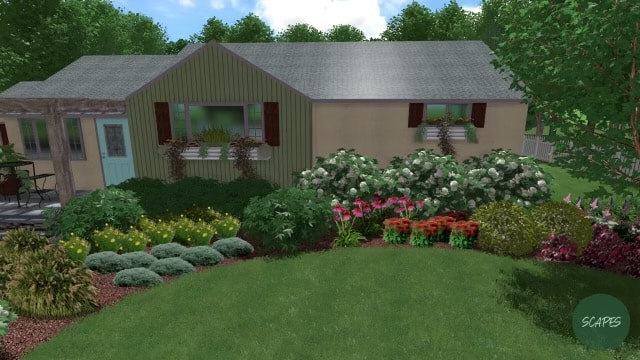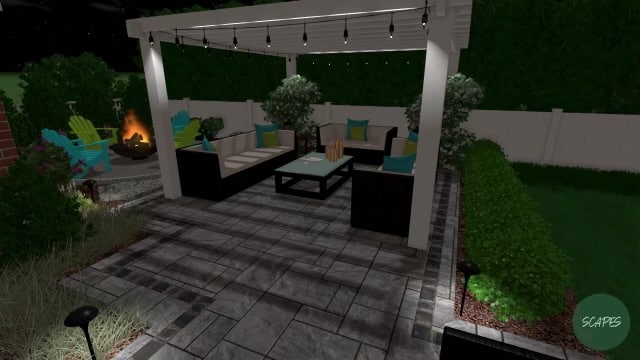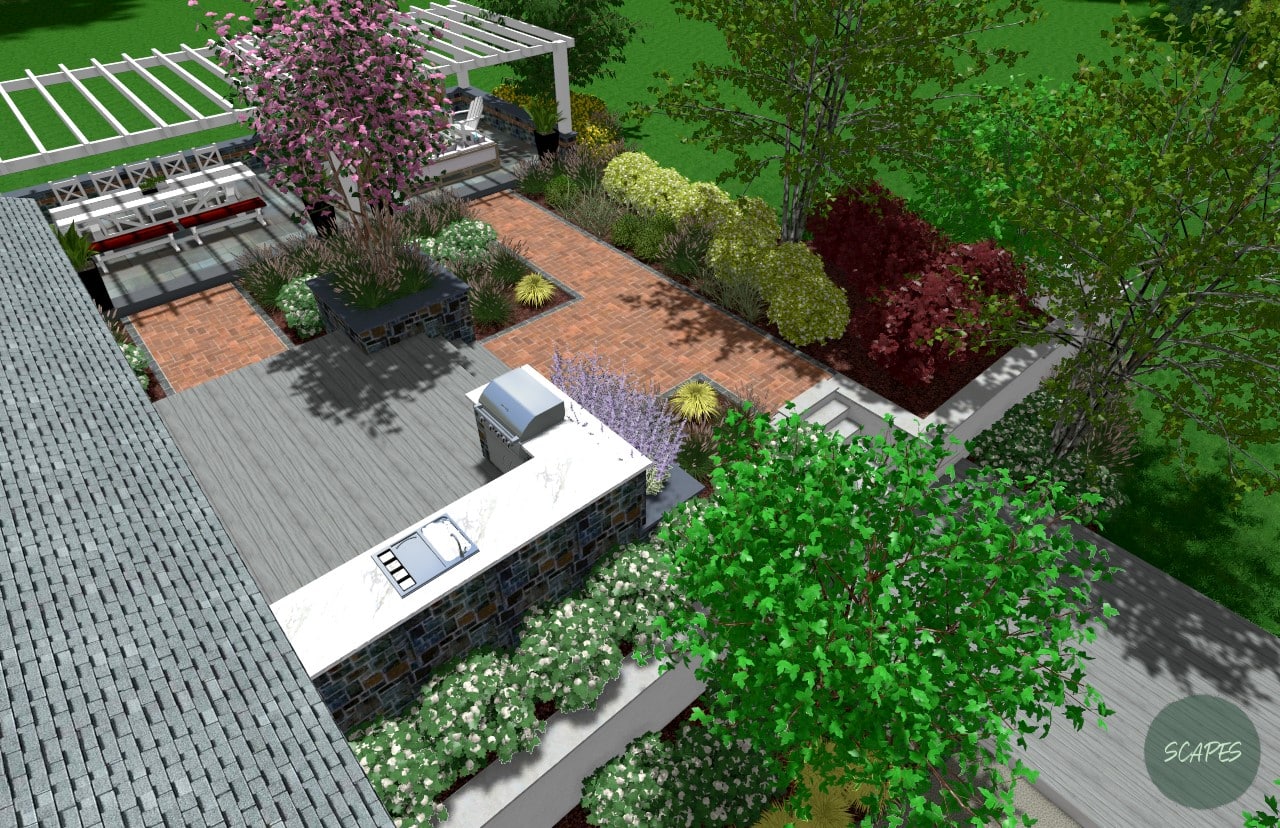So, you have been working hard to save enough money to finally tackle that back yard patio or front yard landscape renovation you have been dreaming about – now what?
Amid squirreling away enough money to pull the trigger on a landscape project, you have probably scrolled through a seemingly endless stream of Pinterest boards and Houzz ideabooks as inspiration for design ideas. The time has now come to (somehow) make sense of all that inspiration and pull together a master plan that will accurately capture your vision.
This can be the most stressful part of any landscape or hardscape project…realizing you have a vision and the funds to build that vision, but not knowing where to begin or how to bring the vision to life. IT SHOULD BE THE MOST EXCITING PART.
Enter the landscape designer.
What does a landscape designer do?
By definition, landscape design “is the analysis, planning, and design of exterior living spaces” (APLDCA.org).
If we put our own spin on this definition, it might look something like “the analysis, planning, and design of exterior living spaces that harmoniously blend function and aesthetic in a manner that achieves the vision of the visionary.”
To be successful, landscape designs must first achieve any functional objectives (think retaining walls to hold back a steep slope) and then attempt to integrate as much aesthetic appeal as possible.
Function is typically very black or white.
For example, if a space is desired in a back yard for individuals to have a place to sit and entertain and a patio is designed large enough to accommodate the intended number of individuals, then function in the backyard design is achieved. Aesthetic, however, is much more subjective. That same patio can be constructed using a variety of materials (or combination of materials) and the aesthetic value will be impacted by the selection of such materials.
With the large number of available materials to build such a patio as referenced in the example and the aforementioned online photo platforms showing thousands of combinations of these materials, achieving a visually appealing design can be a challenging task for those who do not do so on a daily basis.
This is the true value of a landscape design professional – to help clarify an idea through visual representation of a design with high function and aesthetic characteristics.
What does a landscape designer NOT do?
There are some limitations to a working relationship with a landscape designer. The deliverables prepared by a landscape designer are commonly referred to as “conceptual renderings”. This means that they are created with the intent of serving as a visual aid to represent a proposed solution.
For larger scale projects where permitting is required, an engineer or landscape architect may have to become involved to provide “stamped drawings” (think blueprints). Examples of features in a design that may require input from an engineer or architect include swimming pools, decks, pavilions, and retaining walls.
When all conceptual renderings and stamped drawings are finished and the project moves into the construction phase, the job of the landscape designer is typically complete. The landscape designer may have solutions to assist with sourcing a landscaper to implement the design or remain available to answer any questions to assist with the construction.

Front yard renovations (like the one seen above from SCAPES) offer some of the highest ROI for outdoor renovations.
What does a landscape architect do?
A distinction between landscape design and landscape architecture should be provided to help add clarity on when each is best suited for a project.
Landscape architecture, as defined by Oxford Dictionary, is “the art and practice of designing the outdoor environment, especially designing parks or gardens together with buildings and roads.”
As such, landscape architects typically are not the best solution for residential landscaping. When compared to a landscape designer, architects will cost significantly more money for equivalent deliverables.
There may, however, be certain situations where a landscape designer and a landscape architect may work together on a project. For more information on the difference between landscape architects and designers we have dedicated an entire article to the subject.
Flexible, Affordable Landscape Designs

Why should I hire a landscape designer?
The next logical question that would likely come in sequence upon understanding that they are landscape design services that can help realize your vision is why should you hire a professional landscape designer?
The answer to this question is most easily conveyed in a list format, and the bullets below capture many of the advantages of utilizing landscape designing services:
1. To maximize the return on your investment
Landscaping and hardscaping projects can have high return on investment if properly designed to fit the home. We all like knowing that we aren’t wasting money and a landscaping designer can help assure your money is being spent wisely.
Real estate experts hold landscaping and outdoor living initiatives in high regard in terms of return on investment. Some real estate professionals put the return as high as 200-400% for well implemented, intelligently designed projects.
Landscape economist John Harris has performed numerous studies on the matter and states that keeping up with the landscape of your home can contribute a return of up to 28% of your home’s overall value.
2. To reduce the cost of the initial investment
Materials and labor are typically the two biggest cost drivers in an outdoor living space project and understanding the impact of the design on these installation inputs will help reduce the cost of the installation investment.
For example, swapping a concrete paver for a natural stone paving product may save 20%-40%. Swapping a smaller shrubs for the plant material portion of a landscape construction project could also help reduce the cost enough to make it a more manageable investment.
These are the types of alternate solutions that a landscape designer can discuss with you to make sure you get the intended results at a desired price point.
3. To reduce the recurring maintenance burden
An improperly designed landscape or hardscape space may create a burden to maintain in the years to follow. This will not only add recurring cost, but will likely decrease the level of satisfaction in your outdoor space investment.
One of the mantras of the landscape design trade is “right plant, right place.” By selecting the appropriate plant material and placing them in an appropriate location in the design, hours and/or costs required to maintain the visual appeal of the landscape are minimized.
4. To shorten the learning curve and avoid costly mistakes
Landscape designers are a rather narrow-focused profession – they design outdoor living spaces all day, every day. Think of them as your landscape planner, working to save you time sorting through inspiration photos and landscape/hardscape best practices.
A qualified landscape designer should also have formal education or training. This results in an individual who is well versed in industry best practices, including items like incorporating native plants in a design, xeriscapes solutions, or adding landscape lighting to increase the usability of an outdoor living space. It is all knowledge that would take many hours to learn and implement effectively.

Low voltage landscape lighting is a fantastic opportunity to extend the usability of outdoor living spaces.
5. To maximize enjoyment
Like we said earlier, the design component of the project should be one of the most exciting parts of the project. Utilizing a designer as a landscape consultant can maximize not only enjoyment of the design process, but, more importantly, the enjoyment value of the finished product.
In a 2018 study conducted by the National Association of Realtors and the National Association of Landscape Professionals, “Joy Scores” were assigned to the level of enjoyment homeowners gained from a particular project.
The top scores on a scale ranging from 1 and 10 (where a higher figure represents greater enjoyment) were fire features and irrigation systems, both receiving a perfect 10.
The next highest Joy Scores were a new deck (Joy Score of 9.8), water features (9.8), statement landscaping (9.7), a new patio (9.7) landscape lighting (9.6), and an overall landscape upgrade (9.6).
What are the main elements of a landscape design?
Landscape designs can be as simple as adding some flowers to an existing flower bed, or as complex as designing a backyard oasis. Some of the elements you may find in a landscape design include:
1. Landscaping
A fundamental aspect of landscape design is blending nature with a constructed environment, and landscaping is the best way to achieve this. Sometimes overlooked or undervalued in a design, plants can help soften a space or block unwanted views. When designed properly, a landscape should be low-maintenance and add four-seasons of interest to the space – top-tier landscape designs achieve these characteristics while using a native plant palette.
2. Hardscaping
Patio and walkway features of a landscape design are commonly referred to as the hardscape elements. These are the backbone of the functionality aspect of many designs and, when integrated appropriately into a design, can have a very high return on investment. For larger scope outdoor living projects, outdoor kitchens typically fall under the hardscape category.
3. Landscape Lighting
Introducing low-voltage landscape lighting to an outdoor living project is one of the most valuable additions to a project. It not only increases the usability of the space in the nighttime hours, but it also adds safety. Lighting a front yard landscape can help deter burglars and clearly define entryways for guests arriving during darkness. Lighting a backyard outdoor living space increases the entertainment value and can help add safety by lighting areas such as steps.
4. Structures
We typically lump elements such as decks, pavilions, pergolas, or gazebos into a “structures” category. These are value-add features of a design that are typically incorporated to increase the entertainment value or overall usability of a space. Technology has come a long way and new materials are constantly being introduced to lengthen the lifespan of these features compared to wood and they can be just the thing to add final touch on an outdoor living project.
5. Water Features
Many different types of water features can be included in a landscape design. They can be smaller, pondless elements like a bubbling boulder, or more elaborate ponds and streams. Regardless of their shape and size, water features can be a valuable addition to a space for their calming sound.
6. Swimming Pools
In a category separate from the rest of the water features are pools. They come in all shapes and sizes and three main construction materials – gunite, fiberglass, and vinyl liner. Pools can be a fantastic addition to keep a family entertained, or designed in a more intimate manner like a cocktail pool geared towards an adult crowd.
Where do I find a landscape designer?
Finding the best landscape designer is an important step in the process that will help bring that excitement and enjoyment to the landscape project.
There are many factors to consider, so we wrote an entire separate article outlining what to look for when searching for and selecting the designer you will work with.
Since you have already found us, the easiest next step is to explore our delightfully personal, surprisingly affordable landscape design solutions!



